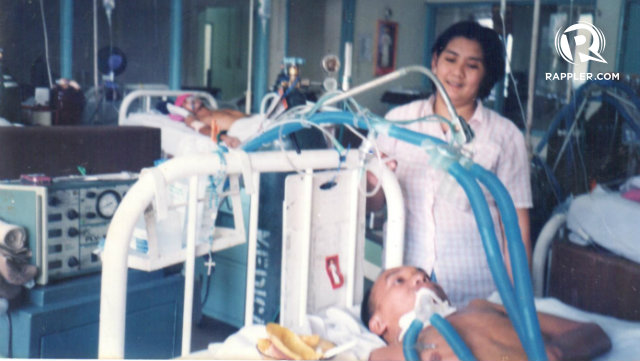SUMMARY
This is AI generated summarization, which may have errors. For context, always refer to the full article.

MANILA, Philippines – Susan and Mario Maniego have lived in a hospital for most of their married life. For the past 17 years, Susan has looked after her husband Mario, a paralytic confined at the Philippine Orthopedic Center. The generosity of kind individuals and donors served as Mario’s second lifeline.
Mario, 49, is suffering from a spinal cord injury he got from a spinal operation in November 1996. He is completely paralyzed and bed-ridden–dependent on respirators and oxygen tanks for his survival.
The Maniegos outstanding debt amounts to almost a million pesos. Their expenses for the past 17 years were sourced from donations and grants given by kind individuals, groups and politicians. Susan tends to her husband daily and has not been able to find work.
If she were given a choice and all the means available, Susan would gladly take Mario home. However the medication assistance needed by Mario for homecare service costs more than the family could afford.
“Hindi naman pwede na umuwi kami ng machine lang. Kailangan ng oxygen refill, tapos ng pagbayad sa kuryente sa respirator. Kailangan din ng kama na recliner, tapos pati ang mga antibiotics niya, saan kami kukuha nun?” Susan explained. (We just can’t go simply go home. We need oxygen refills and the funds to pay for the electricity consumed by the respirator. We also need a recliner bed, not to mention his antibiotics.)
Currently, the Maniegos get by thanks to the free accommodation and oxygen refills given to them by the Philippine Orthopedic Center (POC). However, the free services they receive may end one day, threatened by a shift in the government’s healthcare policy.

Modernization
In 2010, President Benigno S. Aquino launched his administration’s public-private partnership (PPP) program, aimed at funding big ticket projects that the government could not otherwise fund alone.
“Mula sa public private partnerships na ito, lalago ang ating ekonomiya at bawat Pilipino makikinabang,” Aquino proclaimed in his first State of the Nation Address (SONA). (Through public-private partnerships, the country’s economy will grow and every Filipino will benefit.)
For the health sector, a plan to modernize the Philippine Orthopedic Center (MPOC) is in the works.
Under the MPOC project, the government is set to enter a build-operate-transfer (BOT) arrangement with the private sector.
The winning bidder of the P5.69 billion project will build and run a new hospital that will be called the “Center for Bone and Joint Diseases, Trauma and Rehabilitation Medicine,” replacing the 68-year old Philippine Orthopedic Center.
The contract, which will run for 25 years and can be renewed, is expected to pave the way for upgrades in the facilities and services of the hospital.
|
Why the need for a new hospital? |
|
|
Constraints and Issues |
Solutions Facilitated by New Facility |
|
LOW CAPACITY UTILIZATION (only 70%-75% of Sanctioned capacity) |
Private sector operational efficiencies to improve capacity utilization to 90-95% beds |
|
STAFF-TO-BED RATION & DISCHARGE PERIODS (lower than ideal) |
Improved Staff-to-Bed ratio and reduced discharge period |
|
LIMITED MEDICAL SERVICES (only primary and secondary services) |
Super specialty tertiary care with modern equipment and select qualified medical staff |
|
ARCHAIC INFRASTRUCTURE & FACILITIES REQUIRING ESSENTIAL UPGRADATION |
State of the art infrastructure and modern equipment and facilities to be installed and operated |
|
LIMITATIONS IN CATERING TO NON-CITIZEN PATIENTS OR MEDICAL TRAVELERS |
Medical tourism patients identified as part of envisaged overall patient population served |
The winning bidder will pay P5.43 billion while the government will fund the remaining expense of P260 million for the acquisition of land near the National Kidney and Transplant Institute (NKTI).
Nine companies have already expressed interest in the project. They are Siemens Inc. Healthcare Sector, GE Health Care General Electric Phil. Inc., Sta. Clara International Corp., Mount Grace Hospital Ventures, Philips Electronic and Lighting Inc., Metro Pacific Investments, Megawide Engineering Excellence, Strategic Alliance Holding Inc., and Data Trail Corp.
Privatization fears
While the project aims to inject new life into the decades old hospital, not everyone is happy.
The National Orthopedic Hospital Workers Union-Alliance of Health Workers Union (NOHWU) fears the MPOC is a guise for the future privatization of the hospital.
Sean Velchez, president of NOHWU, pointed out that the label of ‘partnership’ is a way of sugarcoating the ‘privatization’ scheme of the project.
“It is sugarcoating kasi paano mong sasabihin na hindi privatization? Mula sa design, acquisition, operation, maintenance and everything for twenty five years, kontrolado ng private entity. Ano ang sinasabi n`on sa ownership (ng gobyerno)?” Velchez said. (How can you say it is not privatization? The private entity controls the design, acquisition, operation, maintenance and everything for 25 years.)
To describe the set-up of the private-public partnership, Velchez likened it to a owning a house.
“Itong si may-ari ng bahay, nagdesisyon siya na gibain at magpatayo ulit ng bagong bahay. Pero after that yung engineer na yung nagdedesisyon ng kung sino ang papatuluyin, ano yung disenyo ng bahay, ano yung gamit ng bahay. Bahay pa rin ba `yon ng may-ari?” Velchez probed. (We have a house owner who decides to replace his house with an entirely new one. However, the engineer decides the design of the house and who is allowed to use it With that kind of set-up, is the house still the owner’s possession?)
Aside from project management concerns, government health workers also fear they will lose their jobs.
Jossel Ebesate, Nurse Supervisor at the Philippine General Hospital and staff regent of the University of the Philippines, said that any modernization project should be fully facilitated by the government.
“I welcome and fully support the modernization of the Philippine Orthopedic Center that is fully owned and operated by the national government for the benefit of our people especially the poor and under served – it is a constitutional duty that must be fulfilled by the government; anything less or any plans or programs that will result to the debasement of this constitutional responsibility is a dereliction of such responsibility,” Ebesate told Rappler.
Partnership
DOH undersecretary Teodoro Herbosa denied the allegations that the MPOC will lead to privatization. According to Herbosa, MPOC cannot be considered a privatization project since the government is not putting the whole hospital for sale. He added the arrangement should be labeled as a ‘partnership.’
Herbosa said the government cannot pursue the modernization of hospitals and health facilities on its own despite the significant increase in the department’s budget in 2013.

According to the DOH, the four main sources of financing are national and local government, insurance, user fees/out of pocket and donors. In 2013, the health sector was allocated P50.4 billion.
|
Hospital |
2010 |
2011 |
2012 |
2013 |
||||
|
Total Budget |
Capital Outlay |
Total Budget |
Capital Outlay |
Total Budget |
Capital Outlay |
Total Budget |
Capital Outlay |
|
|
Philippine Orthopedic Center |
348,809,000 |
15,000,000 |
356,298,000 |
0 |
345,768,000 |
0 |
413,650,000 |
0 |
|
Source: General Appropriations Act 2010-2013 |
||||||||
The total budget allocated to the Philippine Orthopedic Center for 2013 is P413.6 million, with zero appropriation for capital outlay.
According to Herbosa, if the government would build a new hospital comparable to St. Luke’s Global Center in Taguig, it would cost P10 billion. This is roughly equivalent to almost one-fifth of the total budget allocated to the health sector.
“We want to build hospitals but we are not going to use tax money because we can use that for roads, airports and other infrastructure projects. We can use that for vaccination and for other important health issues,” Herbosa explained.
NOHWU refuses to accept the excuse that the government does not have enough money to finance the construction of new hospitals. Velchez cited the P40 billion for the conditional cash transfer program and the P4 billion in expected revenues from the Sin Tax as evidence that the government has the money.
Velchez clarified that they are not objecting modernization schemes.
“We are never against modernization. Health is a basic right. It should be accessible and it should be provided by the government.”
End of charity?
Susan Maniego is worried. Though she understands that the proposed modernization may result in better services, she fears the hospital may turn into a business venture solely out for profit.
“Ang ibig lamang ng pangulo, gumanda ang ospital at magkaroon ng makabagong equipment ang ospital para hindi na tumatakbo sa ibang ospital. Pero hindi ko nga alam kung ano nga ang mangyayari kung privatization na nga. Kasi ako man natatakot. Kasi kapag nagprivate, lahat talaga babayaran mo,” said Susan. (I know that the president only wants to upgrade the hospital with new equipment. However, if privatization happens, I won’t know what to do. I am afraid that if the hospital is privatized, we will be required to pay for all hospital costs.)
Her concerns are echoed by other patients, who depend heavily on affordable and accessible hospital services. Almost 90% of patients in the POC benefit from subsidized healthcare.
Fixing a sick system
According to the World bank, the Philippines allots only 4.1% of its gross domestic product (GDP) to health. This is in contrast to the recommended ratio by the World Health Organization (WHO) of 5% of GDP.
No new public hospital has been built in the country for the last thirty years. The healthcare system is in dire need of a quick remedy.
While access to healthcare is a right, it certainly does not come cheap. The question that’s left to be answered is who should pay for the bill? – Rappler.com
Add a comment
How does this make you feel?
There are no comments yet. Add your comment to start the conversation.